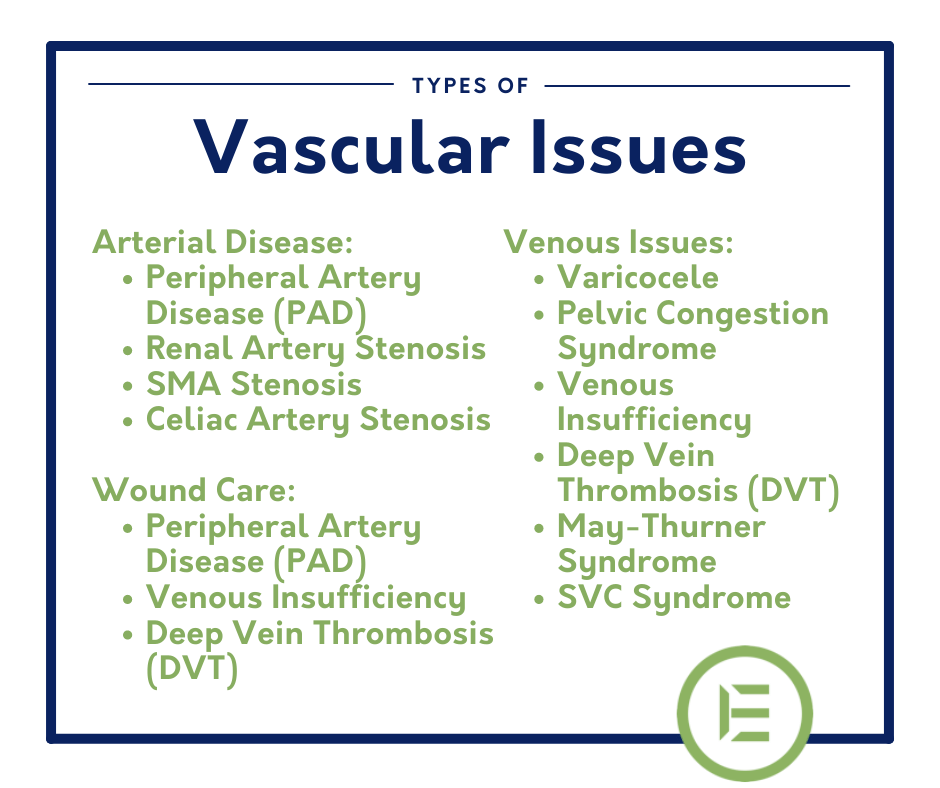Your body’s blood vessels are so vast that they would be long enough to go around the world more than twice. So when do you need an endovascular specialist to care for your intricate system of veins and arteries?
Your primary care physician or podiatrist may refer you to an endovascular specialist for diagnosis and non-surgical, minimally invasive treatments that are highly effective.
“We know that [Dr. Kovaleski] has good outcomes,” primary care physician Dr. Julianne Garrison said. “They take good care of our patients. They’re not going to have unnecessary costs and fees that we might see with a hospital.”
WATCH DR. GARRISON’S INTERVIEW HERE
Are your circulation problems serious? If you are a smoker, a diabetic, obese, or have high blood pressure, you fall into a high-risk category for vascular disease.
What is an Endovascular Specialist?
Endovascular specialists are Interventional Radiologists expertly trained in minimally invasive procedures to address problems affecting the vascular system. The vascular system, or the circulatory system, is an intricate network of vessels throughout the body. They walk each patient through every treatment option to find the best option for long-term health and comfort.
Additionally, endovascular specialists are trained in wound care and can treat non-healing or chronic wounds which affect approximately 6.7 million Americans.
“I really enjoy working with an independent outpatient vascular group that can take care of a number of issues for my patients,” said Dr. Garrison. “We refer for a number of different reasons.”
If you are experiencing any of the following symptoms, it may be a sign of a more serious vascular condition.
What are the common symptoms of circulation problems?
Pain and numbness in your legs when you walk or climb stairs and burning pain in your toes and feet while at rest can be signs of Peripheral Artery Disease (PAD). PAD affects about 20 million Americans and is a result of narrowed arteries reducing blood supply to your legs. An endovascular specialist can determine if your legs are receiving normal levels of blood flow.
If you are struggling with nausea, abdominal pain, increase or decrease in urination, or bowel dysfunction, this may be a sign of stenosis, including Renal Artery Stenosis, SMA Stenosis, and Celiac Artery Stenosis.
If your legs are swollen, aching, and discolored and you develop ulcers or wounds, this can be a sign of a venous issue. Complaints like these may appear strictly cosmetic, yet they can be indicators of an underlying vascular condition.
Types of vascular issues include…
How do you treat vascular problems?
The best way to treat a vascular issue is to make an appointment with an endovascular specialist. You may schedule an appointment yourself or your primary care physician or podiatrist may refer you. After diagnosis, your physician will draw up a personalized and highly effective plan using non-surgical, minimally invasive treatments.
For example, before treatment for PAD, our physicians identify arterial blockages through injected dyes visible through X-ray. Depending on the location of the blockages, they then perform treatments including balloon angioplasty, atherectomy, or stent placement.
If you’ve been diagnosed with a circulatory issue and want to discuss your options, contact ECCO. Our expert physicians will help you determine which treatment option is right for you.
ECCO Medical – 8080 Park Meadows Dr. Suite 150, Lone Tree, CO 80124





